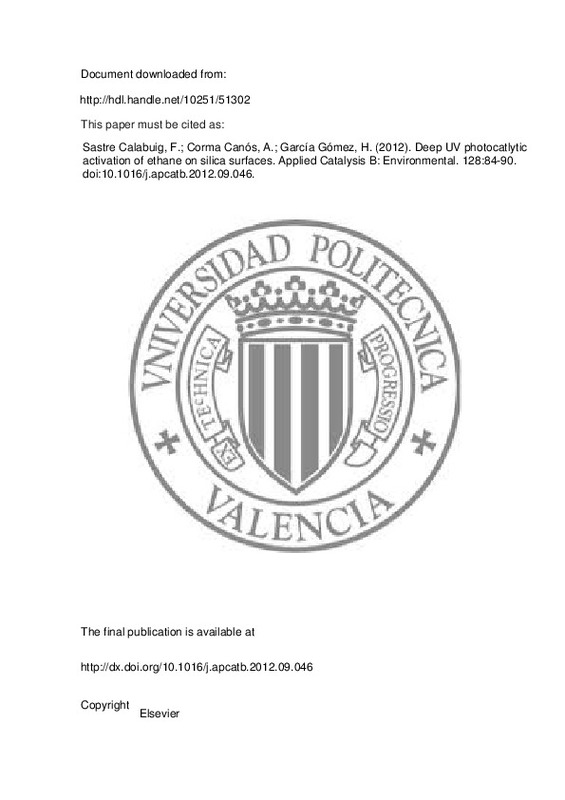JavaScript is disabled for your browser. Some features of this site may not work without it.
Buscar en RiuNet
Listar
Mi cuenta
Estadísticas
Ayuda RiuNet
Admin. UPV
Deep UV photocatlytic activation of ethane on silica surfaces
Mostrar el registro sencillo del ítem
Ficheros en el ítem
| dc.contributor.author | Sastre Calabuig, Francesc
|
es_ES |
| dc.contributor.author | Corma Canós, Avelino
|
es_ES |
| dc.contributor.author | García Gómez, Hermenegildo
|
es_ES |
| dc.date.accessioned | 2015-06-05T10:30:15Z | |
| dc.date.available | 2015-06-05T10:30:15Z | |
| dc.date.issued | 2012-11-30 | |
| dc.identifier.issn | 0926-3373 | |
| dc.identifier.uri | http://hdl.handle.net/10251/51302 | |
| dc.description.abstract | Deep UV photolysis (165 or 185 nm) of surface silanol groups leads to the homolytic Osingle bondH bond breaking, generating silyloxyl radicals and hydrogen atoms. Silyloxyl radicals are able to activate ethane through hydrogen abstraction, whereby ethyl radicals are formed. Coupling of these ethyl radicals with silyloxyl radicals forms surface bound ethoxysilane that eventually will form ethanol. The product distribution of this radical process depends on the absence or presence of oxygen and may lead to the formation of ethanol together with light alkanes (methane, propane, butane and hexane) accompanied by C2 (acetaldehyde and acetic acid) and C1 (methanol, formaldehyde and formic acid) oxygenates. The presence of oxygen enhances ethane conversion and quenches the formation of alkanes by trapping alkyl radicals. It was found that micro and mesoporous silicas behave qualitatively similar with some differences in the product distribution. The most efficient material (higher conversion and higher percentage of products in the solid) was found to be Al-MCM 41. The energy consumption estimated based on a conversion of 6% on commercial beta zeolite was 2.0 Gcal per mol of ethane converted that is about 3.6 times smaller than the energy consumed form methane activation through an analogous process. | es_ES |
| dc.description.sponsorship | We would like to express our most sincere gratitude to Prof. J.-M.-Herrmann that during all his career has been a guide and a reference for us in the field of photocatalysis. Financial support by the Spanish MICINN (Consolider Ingenio MULTICAT and CTQ2012-32315) is gratefully acknowledged. | en_EN |
| dc.language | Inglés | es_ES |
| dc.publisher | Elsevier | es_ES |
| dc.relation.ispartof | Applied Catalysis B: Environmental | es_ES |
| dc.rights | Reserva de todos los derechos | es_ES |
| dc.subject | Photocatalysis | es_ES |
| dc.subject | Ethane activation | es_ES |
| dc.subject | Deep UV photolysis | es_ES |
| dc.subject | Aluminosilicates as photocatalysts | es_ES |
| dc.subject.classification | QUIMICA ORGANICA | es_ES |
| dc.title | Deep UV photocatlytic activation of ethane on silica surfaces | es_ES |
| dc.type | Artículo | es_ES |
| dc.identifier.doi | 10.1016/j.apcatb.2012.09.046 | |
| dc.relation.projectID | info:eu-repo/grantAgreement/MINECO//CTQ2012-32315/ES/REDUCCION FOTOCATALITICA DEL DIOXIDO DE CARBONO/ | es_ES |
| dc.rights.accessRights | Abierto | es_ES |
| dc.contributor.affiliation | Universitat Politècnica de València. Instituto Universitario Mixto de Tecnología Química - Institut Universitari Mixt de Tecnologia Química | es_ES |
| dc.contributor.affiliation | Universitat Politècnica de València. Departamento de Química - Departament de Química | es_ES |
| dc.description.bibliographicCitation | Sastre Calabuig, F.; Corma Canós, A.; García Gómez, H. (2012). Deep UV photocatlytic activation of ethane on silica surfaces. Applied Catalysis B: Environmental. 128:84-90. https://doi.org/10.1016/j.apcatb.2012.09.046 | es_ES |
| dc.description.accrualMethod | S | es_ES |
| dc.relation.publisherversion | http://dx.doi.org/10.1016/j.apcatb.2012.09.046 | es_ES |
| dc.description.upvformatpinicio | 84 | es_ES |
| dc.description.upvformatpfin | 90 | es_ES |
| dc.type.version | info:eu-repo/semantics/publishedVersion | es_ES |
| dc.description.volume | 128 | es_ES |
| dc.relation.senia | 240606 | |
| dc.contributor.funder | Ministerio de Economía y Competitividad | es_ES |







![[Cerrado]](/themes/UPV/images/candado.png)

